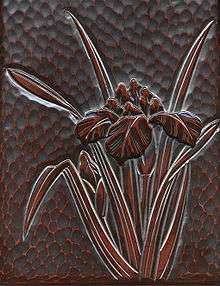Kamakura-bori

An example of Kamakura-bori

Enlargement showing how polishing reveals layers
Kamakura-bori (鎌倉彫) is a form of lacquerware from Kamakura, Japan. It is made by carving patterns in wood, then lacquering it with layers of color. It is then polished.
The genre is said to date to the Kamakura period, when Kōun (康運) (or, according to another theory, Kōen (康円), a busshi (a sculptor specializing in Buddhist images), began carving racial Buddhist implements in the manner that Chin Na-kei (or Chin Wa-kei) had introduced from the Song Dynasty in China.
Kamakura-Bori was typically produced for the ruling class of feudal Japan, and often depicts religious/political figures. Kamakura-Bori was for all people who owned a home: almost all home-owners had some form of Kamakura-Bori crafts.
See also
- 鎌倉彫 (Kamakura-bori) in the Japanese Wikipedia.
This article is issued from Wikipedia - version of the 11/11/2016. The text is available under the Creative Commons Attribution/Share Alike but additional terms may apply for the media files.